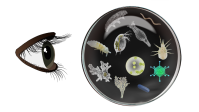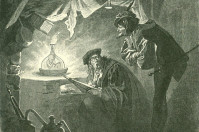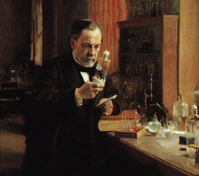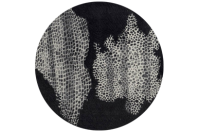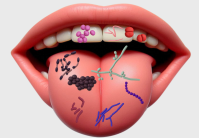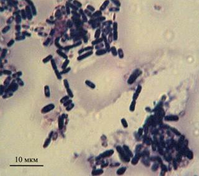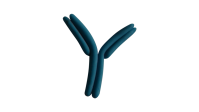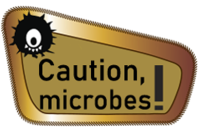-
Who Lives in the Microworld
The world around us is far less obvious than it appears. And this is true in a very literal sense—not everything is visible to the naked eye. A vast number of microorganisms surround us. What they are and where they live is something we will uncover in this lesson.
What they are and where exactly they live, we will figure out from this lesson.
Video lesson on YouTube
-
How to Look Under a Microscope
Today, we will learn how to use a microscope step by step: how to prepare it, what to place on the stage, how to adjust the settings, where to focus your view, and how to capture photographs of the results. Additionally, we’ll explore what types of objects can be observed under a microscope and which ones are beyond its capabilities.
-
Working Principles and Functionalities of Microscopes
Microscopes come in many types, each with unique functionalities. For instance, a binocular microscope allows you to magnify patterns on the skin of your fingers. In contrast, with a transmission light microscope, examining your fingers won’t work, but it’s perfect for studying plant cells. Both devices provide magnified views, yet their applications differ. An X-ray diffractometer, on the other hand, offers such incredible magnification that it reveals the structure of individual molecules. However, what it displays is far from resembling macro photography.
In this lesson, we will explore the functions and uses of various magnifying devices.
-
Is Spontaneous Generation Possible?
Since ancient times, humanity has approached the question of life's origins in fascinating ways. There was once no doubt that living beings—or at least the simplest forms—could spontaneously arise. Oh, how challenging it was for people to let go of these long-held beliefs, even in the face of ingenious experiments that demonstrated the principle "Omne vivum ex ovo" ("all living things come from an egg").
-
Who First Saw Microbes
Who was the first to see microbes? The answer to this question is not as straightforward as it seems—it wasn’t Antoni van Leeuwenhoek, as many might assume. Leeuwenhoek was the first to not only observe the microworld but also comprehend what he saw. What occurred before his discovery and the surprising events that followed will be revealed in this lesson.
- Microbial Art
Microorganisms can be stunningly beautiful. They can form intricate frosty patterns on windows, illuminate the night with their glow, and even in the simplest mold, reveal the perfection of the natural world. Would you like to witness their beauty too?
- Louis Pasteur is a Microbiological Hero
In our time, so many inventions have been made that creating even one more is an achievement. However, Louis Pasteur lived during the golden age of discovery and innovation, and he was an incredibly talented individual. Grab your pens and notebooks and start listing all the remarkable things he discovered!
- Staining and Slicing
Transparent objects or those matching the background color are easier to study under a microscope after staining. In this lesson, students will learn to stain bacteria using methylene blue and practice using an immersion lens. Additionally, they’ll explore creative approaches to staining different objects and discover what to do if they want a vibrant multi-colored image under the microscope without the effort of staining.
-
- Molds
Sometimes it happens that you bought grapes, for example, or maybe cucumbers. Or bread. Anything, any food that has a little moisture in it. And this food, after a while, goes bad. You can't eat. It is covered with a cute fluff, which may look pretty (at least if you look through the eyes of a microbiologist), but irrevocably spoils the food.
We usually call this fluff "mold." In science, it is called a "microscopic fungus."
Today, I will tell you why it grows on food and how it differs from large mushrooms (the difference is not as big as one might think). I will also teach you how to identify molds that are more common at home.
- The World in a Drop of Water
Forgive me, I couldn’t resist the somewhat clichéd name "The World in a Drop of Water." It’s a title that appears quite often, but does a single drop truly contain an entire world? The answer might be a bit disappointing. If you’re hoping to witness a bustling city of microscopic creatures living captivating lives, a drop of seawater won’t quite deliver. It holds countless viruses and bacteria, but none of them wave their paws or roll their eyes, since they lack both. As for multicellular organisms, many simply won’t fit within such a tiny volume. You might find a Daphnia in a single drop, but calling it a whole world would be a stretch. There’s just not enough room.
So why stop at just one drop? Let’s explore ten. Or a hundred. Maybe even a bucket. Let’s dive in and see what marvels drift within.
- Who Lives on the Human Body?
The answer is simple: there are an extraordinary number of bacteria. But that’s not a cause for concern. Most of the bacteria that live with us constantly are harmless and pose no threat. We are like a cozy, walking canteen for them—they thrive on our warmth and the steady supply of nourishment we provide. They’re simply delighted that we’re alive and well, ensuring their food and comfort keep coming.
So, don’t fret—take a closer look at these tiny companions riding along with us.
- The Structure of Prokaryotic Cells
As much as we might hope to see something extraordinary under a microscope, bacteria are surprisingly simple in structure. No tails, no eyes, no legs. Observing them through a microscope often feels like deciphering Morse code—a dot, a dash...
Despite their simplicity, bacteria exhibit specific and distinct shapes. In today’s lesson, we will learn how to identify these shapes and explore the internal structure of a bacterial cell.
What Are Bacteria, How They Differ from Archaea and Eukaryotes, and Their Role in Our Lives on YouTube
- How do Bacteria Differ From Us?
It might seem like such a straightforward question. Here we are, and there are the bacteria. At first glance, it’s hard to imagine anything we have in common—the differences are undeniable. But the microcosm often defies expectations. In this hidden world, things may not be as they appear.
-
Morphotypes of Bacterial Colonies
As we already know, bacteria are incredibly small, so small that a single bacterium is invisible to the naked eye and can only be seen with a microscope. However, they possess an extraordinary ability to reproduce at an astonishing rate. Where there was just one bacterium yesterday, there might be millions today—and that’s when they become visible to us.
Interestingly, this phenomenon can even appear quite charming. See for yourself!
-
Microbes - Our Little Helpers
Some microbes live independently and are known as "free-living." Others take resources from other organisms without contributing anything in return—these are called "parasites." But there’s another remarkable group: those who provide help to others. These are known as "mutualists."
In this lesson, we’ll explore how and to whom mutualistic microbes offer their assistance. We’ll also uncover surprising examples of how help can come from the most unexpected places.
- Viruses Are Harmful Substances
Your text is already fascinating and well-structured! Here's a refined version for enhanced clarity and flow:
In 1885, Louis Pasteur developed the rabies vaccine—remarkably, without knowing the exact cause of rabies! It’s no surprise that the pathogen was so elusive. At the time, Pasteur was familiar with microscopic fungi (yeast) and bacteria, both of which are much larger than viruses and visible under a transmission light microscope. Viruses, however, remained invisible.
How did scientists eventually manage to detect these hidden entities? That’s what we’ll uncover in today’s lesson.
-
What Is Immunity?
Immunity is the body's defense mechanism, designed to identify, destroy, and eliminate anything foreign that poses a threat. Without it, people would constantly fall ill and likely wouldn't live to old age.
In this lesson, we’ll explore the fascinating mechanisms of how immunity functions.
-
Caution, Microbes!
Microbes are invisible to the naked eye, yet they are omnipresent, surrounding us and waiting for the right moment to invade our bodies. But how can we combat something that we cannot see? The game "Caution, Microbes" will reveal the answers!
